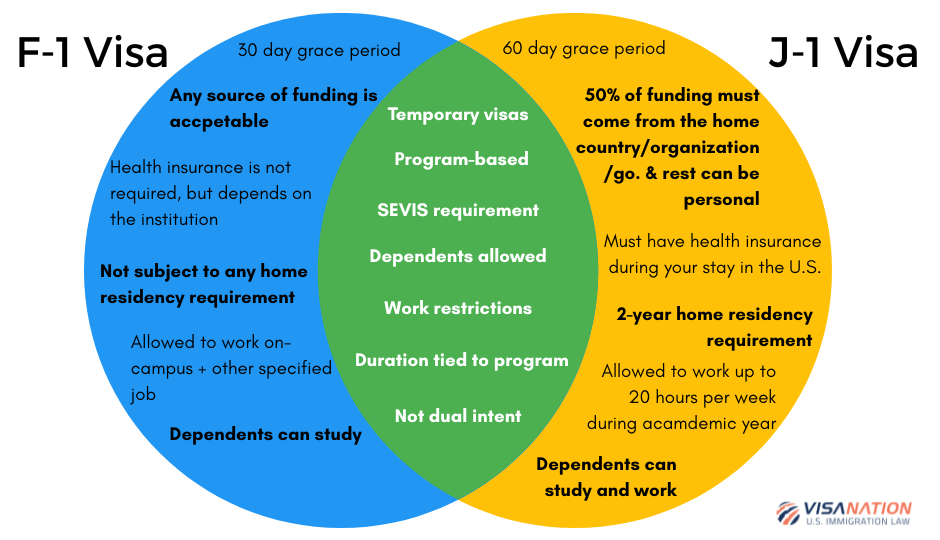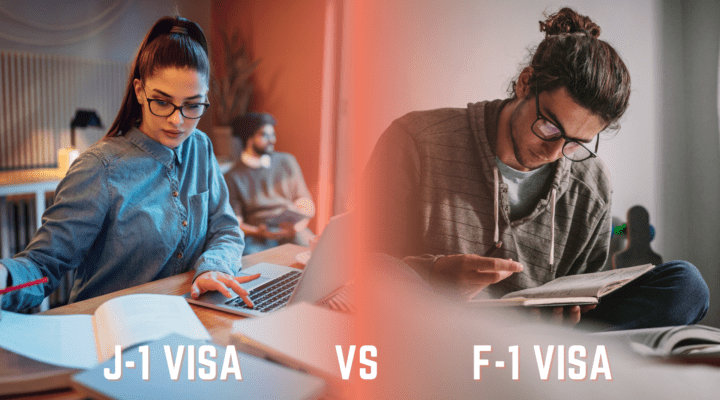Studying in the U.S. can be a great benefit to those who wish to learn and gain degrees and certifications from institutions in the U.S. In this article, you will learn about the difference between J-1 and F-1 visas. These two visas are the two most common visa options for foreign residents seeking to study in the U.S. After comparing J-1 vs F-11 visas, you will be able to identify which one suits your situation best. However, deciding between the two can be difficult without some background information. Find out what the advantages and disadvantages are of each visa, as well as how you can determine the best visa for your particular immigration situation.
J-1 Visa
The J-1 visa is called the “exchange visitor visa.” Rather than have a sponsoring employer, J-1 visa holders have sponsoring programs that are approved by the Department of State. This visa is intended for foreign citizens from all over the world to gain skills in the U.S. to take back to their respective home countries. For this reason, each person who enters the U.S. under J-1 status is required to return home for at least two years before coming back to the U.S., a feature called the “home residency requirement”.
However, if you would like to avoid the home residency requirement, then you can do so by submitting a J-1 visa waiver. There are four waiver classifications:
- A statement of No Objection from your home country’s government
- Evidence that returning to your home country would expose you to persecution
- Evidence that returning to your home country would result in extreme hardship for your family members
- Having a U.S. government agency express interest in having you remain in the U.S. after your J-1 stint (IGA waiver)
Here are the programs that the J-1 accommodates:
- College and University Student
- Secondary School Student
- Research Scholar
- Short-Term Scholar
- Specialist
- Intern
- Government Visitor
- Summer Work Travel
- Camp Counselor
- Physician/Doctor
- Professor
- Teacher
- Trainee
- Au Pair
- International Visitor
Your length of stay will depend on the program you choose. While some specific programs, like a program for a professor, may have a maximum duration of up to 5 years, the maximum duration for an exchange student may only be 3 years.
F-1 Visa
The F-1 visa is one of two student-specific visas, the other being the M-1 for vocational schools. Through the F-1, you will be able to live, study, and in some cases work in the U.S. for the duration of your scholastic program.
The F-1 is for those who wish to enroll in a:
- Private elementary school
- High school
- College
- University
In order to qualify, you must show:
- That you are maintaining a permanent residence outside of the U.S. This should be substantial enough to show that you have an incentive to return home after your stint.
- That you have other assets that would cause you to return home, such as property, a car, family, a bank account, or a job offer.
- That you can financially support yourself while you are in the U.S.
- That an institution for education has or will sponsor you for your visa.
Find out about the F-1 OPT grace period.
Difference Between F-1 and J-1 Visa
There are many differences between F-1 and J-1 visas. While both are suitable for foreign students and professionals who want to study in the U.S., some key differences are related to your ability to work during your studies and after the completion of your studies. Your funding requirements will differ dramatically depending on which visa type you choose. See the table below for a quick comparison summary.

Studying in the US: F-1 vs J-1
Both the J-1 and the F-1 are designed with the student in mind. Most people who wish to study in the U.S. choose one of these two options, and this may very well be the reason you are reading this now.
Both visas allow you to study at any secondary school or University in the country and obtain any degree or certification that requires earned credits. However, both require you to be sponsored by the institution that you will be studying with. This means that you cannot simply transfer to a new school without also having that school assume your sponsorship.
Working in the US: F-1 vs J-1
A large difference between the J-1 and F-1 visas is the access you may have to regular employment. J-1 students are permitted to work provided that they obtain work authorization. However, most J-1 programs (meaning schools) will only allow you to work on campus for 20 hours per week (part-time). You could work as a teacher’s aide, custodian, in food service, in the library, bookstore, or even as security. You will have to contact your institution to see what jobs are available to you as a J-1 student.
On the other hand, the F-1 allows students to work on and off-campus. However, during their first year, they can typically only work on campus. After your first year is over, you can choose between:
- Curricular Practical Training (or CPT) – this is a work avenue that is a part of your school curriculum, which may include paid or unpaid internships.
- Optional Practical Training (or OPT) – you can choose between pre-completion or post-completion OPT to work while you are studying. This kind of work can only be done if it is directly related to your field of study. If you choose post-completion, you can stay 1 full year after your studies have concluded.
- STEM (Science, Technology, Engineering, and Mathematics) OPT – Simply put, this allows you to stay and work for 2 full years after your studies have concluded.

Difference Between F-1 and J-1 Visa: Getting a Green Card
Some nonimmigrant visas are considered “dual intent” visas because they allow you to pursue immigrant status (green card status) without impacting your current nonimmigrant status. Unfortunately, neither the J-1 nor the F-1 visa is dual intent. This means that applying for a green card could result in the revocation of your J-1 or F-1 status and potentially lead to a bar being placed on you, preventing you from returning to the U.S. for a specified period.
For both of these visas, the intent is for you to learn and train in the U.S. before returning to the betterment of yourself and your home country. Therefore, you must prove that you have a permanent residence in your home country as well as strong ties that would be a reason for you to return (e.g. bank accounts, vehicles, family, etc.). You must also affirm that you intend to leave the U.S. after your J-1 or F-1 validation period is over.
However, there are exceptions through family-based petitions.
- An F-1 visa holder who enters a genuine marriage with a U.S. Citizen or Lawful Permanent Resident may pursue a marriage-based green card.
- J-1 visa holders must first confirm that they are not subject to the two-year home residency requirement before starting the marriage-green card process.
The keyword is a genuine marriage. If there is any suspicion that you entered the marriage for immigration purposes, then your petition will most likely be flagged.
So, in order to apply for your green card, you will need to transfer your status to that of a dual intent visa. Here are some of the common options and their requirements:
H-1B Visa
This has been the most popular dual intent visa, as it allows you to work full/part-time, work concurrently for multiple employers, and transfer your employer. To qualify, you need to have a job offer from a U.S. employer, and you must also have the required degree that adheres to your speciality occupation.
The drawback is the fact that, due to its popularity, the USCIS has imposed an annual cap on the number of H-1B visas that are issued each year. Every year, there is a random lottery to decide which petitions can go into processing. Because several hundred thousand petitions are filed every year and only 85,000 are selected, the odds of winning the H-1B lottery can be slim. Additionally, H-1B visas are now facing constraints due to the introduction of a new $100,000 fee for new H-1B visa petitions filed on or after September 21, 2025. Due to this new fee, many employers and prospective H-1B applicants will likely need to reevaluate whether an H-1B visa is the most suitable for them. The new $100k fee is to be paid by the employer, and many companies may reconsider sponsoring new candidates due to this financial burden.
With the new H-1B proclamation we anticipate this impacting the overall number of H-1B petitions filed. Other employers will start to explore other visa options like an L-1, O-1 or other employement-based visas.
L-1 Visa
If the idea of going through the lottery doesn’t appeal to you, there is always the L-1 visa for international employee transfers. This visa class is broken down into two subcategories. The L-1A visa is for managers and executives, while the L-1B is for employees with specialized knowledge.
In either case, you need to work for one year at a company in your home country that has an office, affiliate, branch, or subsidiary in the U.S. Your company can then use the L-1 to transfer you to the U.S. location. Fortunately, there are no annual caps or educational requirements for this visa.
O-1 Visa
This last dual intent visa is less popular because the requirements are much higher than those of most visas. The O-1 is for aliens with extraordinary achievements in areas like business, science, and art.
EB-2
For J-1 and F-1 visa students who were pursuing advanced degrees in the U.S., the EB-2 green card may be ideal for your situation. Having an advanced degree will automatically qualify you for an EB-2, as long as you are admissible to the U.S. The other requirement is to have exceptional ability, which you can prove by submitting evidence listed on our EB-2 page.
You will need to have an employer sponsor you, and that employer will have to obtain a PERM Labor Certification. This means that an extensive recruitment process must take place to ensure that there are no U.S. workers whose job opportunities would be jeopardized by your employment.
You can also file for a National Interest Waiver (NIW) to bypass the PERM and sponsoring employer requirements.
EB-3
The EB-3 generally takes longer to obtain, but the qualifications are more accessible. To be eligible, you need to either have a bachelor’s degree or have more than 2 years of experience in your field. With less than 2 years of experience, you can qualify for the “other workers category”, which has slightly different priority date waiting times. Essentially, as long as you have a U.S. job offer for a position that is not temporary or seasonal, you should be able to qualify for an EB-3.
J-1 or F-1 to Green Card Process
So, if you are under J-1 or F-1 status, here are the steps you need to take to get an employment green card:
- Choose both a dual intent non-immigrant visa and a green card that best fit your situation
- File the I-129 petition for that visa, along with your I-140 for the green card (can file concurrently depending on the visa), along with the necessary supporting evidence and filing fees.
- If your green card requires a PERM Labor Certification, then your employer will need to go through the Department of Labor to perform thorough recruitment for your position, including placing ads and interviewing qualified candidates. This step can take up to nine months unless your employer is audited (either randomly or targeted), which could extend this period sometimes up to 1-2 years.
- Wait for your priority date to be current
- Your priority date is the day that the USCIS receives your I-140 petition
- Stay up-to-date with the latest visa bulletin from the Department of State, which posts monthly final action dates based on the type of green card you are pursuing and your country of origin.
- Your priority date is considered current when the final action date in your category matches or passes your priority date.
- Make sure that your I-140 has been approved once your priority date is current.
- File an I-485 Application to Adjust Status or Register Permanent Resident and wait for approval.
You can also pursue a family or marriage-based green card, which follows the same steps, except the petitions will be different. Speak with your immigration attorney to determine which route is best for your unique case.
Other Options
The J-1 and F-1 visas are not the only options to live and study in the U.S. For example, many secondary visas allow holders to study. These include the H-4, L-2, O-2, and E-2 dependent visas. Through these visas, spouses and dependents of the primary visa holders (e.g., H-1B, L-1, O-1, etc.) can study at most institutions. Some even allow spouses and dependents to apply for Employment Authorization Documents to work simultaneously. If the F-1 or J-1 visas are not options for you, you may want to consider these visas if a spouse or parent already has nonimmigrant status in the U.S.
J-1 v. F-1 Common FAQs
Which is better F-1 or J-1 visa?
The decision of whether you should pursue the F-1 or the J-1 visa is based on both your current situation and your plans for the future. As a student, both visas are great opportunities to learn without restriction in the United States. However, the main difference comes when you consider if and how you would like to work during or after your studies. For this, the F-1 visa is usually the better option, as it allows you to work off-campus in your field and even allows you to work for one to two years after your studies are over with an OPT. In contrast, the J-1 only allows you to work under specific regulations of your exchange program.
Additionally, the F-1 does not require holders to return to their home countries after their validation period is over. However, this is not an obstacle for the J-1 if you can secure a No Objection Statement from your home country’s government.
What is the difference between an F1 vs J1 visa for studying in the U.S.?
An F-1 visa is designed for foreign nationals to enter the U.S. as a full-time student to attend a SEVP-certified school. In contrast, a J-1 visa is an exchange visitor visa that allows exchange teachers or students to enter the U.S. to participate in an exchange program for teaching, lecturing, studying, observing, or conducting research.
How does choosing between an F1 or J1 visa impact an international student's ability to study, work and stay in the U.S. after graduation?
Both visas allow full-time study at a U.S. institution, but the J1 visa often requires sponsorship through a program or another funding source, whereas an F1 visa can be self-funded. F1 students can work on campus initially, then obtain CPT or OPT to work off-campus, and J1 students are typically restricted to work only under the terms of the specific exchange program. In terms of staying in the U.S. after graduation, you typically have some time with an F1 visa using your OPT to work for a bit, whereas with a J1 visa, you may face the two-year home residency rule, where you would most likely have to return to your home country after graduation.
Can I have a J1 and F1 visa at the same time?
No, you cannot hold both a J-1 and an F-1 visa at the same time. You can transition from a J-1 to an F-1 visa, or vice versa.
What forms are used for the F1 and J1 visa?
You are issued an I-20 form for an F-1 visa and a DS-2019 for a J-1 visa.










